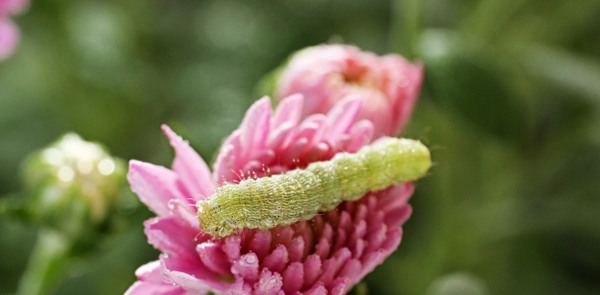Fall is generally the heaviest season for caterpillar pressure. But these leaf-eating pests can appear and proliferate throughout the growing season outside the greenhouse, especially during the warmer months. Growers can combat caterpillars through an integrated pest management approach that includes scouting and applications of BT NOW®, an easy-mixing, water-based, biological insecticide from BioSafe Systems. It utilizes a novel strain of the bacterium, Bacillus thuringiensis ssp. kurstaki (Btk), to offer targeted control of caterpillars on a wide variety of plants. Btk contains natural insecticidal endotoxins called “cry toxins” that target the digestive systems of caterpillar larvae.

“The Btk strain in BT NOW is well-researched and established as an effective biological control organism,” says Gretchen Pettis, Ph.D., the Entomologist and Pacific Northwest Territory Sales Representative for BioSafe Systems.
Scouting is important for every pest, but especially for caterpillars because they can be difficult to spot due to camouflage. They are also voracious eaters that can damage plants quickly, Pettis stresses. Growers need to understand which of their plants are most susceptible to caterpillar feeding, so they know when and what to scout for, she adds, noting that growers also benefit from teaching their employees, formally or informally, the essentials of scouting.
A key sign of caterpillar pressure is the appearance of frass – small brown and green caterpillar excrement pellets – that appear on leaves, benches, and shade cloth below the area of feeding. It’s proof that caterpillars are consuming plants and active, Pettis notes. Other pest pressure signs are leaves that appear chewed, tattered, or missing except for the midvein from plants. Branch dieback may occur if larvae chew stems, she says, adding that growers should also scout for “window painting,” which can cause curling and browning of leaves caused by young caterpillars that are feeding only on the soft tissue between the veins and often only on one side of the leaf.
Pettis doesn’t recommend treating preventively for caterpillars unless growers know for certain that a breakout is looming. But once pest presence is determined and identified, she suggests an application of BT NOW. When caterpillars ingest it, their digestive systems become paralyzed within hours, halting further crop damage potential. Affected larvae die within 2-5 days.
“Caterpillars stop feeding, which is huge,” Pettis says. “Even if you still see caterpillars alive, I promise they have bad stomach aches, and their mouths are paralyzed and can’t function. The affected caterpillars will die of septicemia or starvation within a couple of days.”
Timing Is Everything
Pettis stresses caterpillars are best treated with BT NOW before they grow too large, which is why scouting is vital. She says caterpillars consume 90% of their overall diet in their last stages of development and can grow from an egg to an adult in 7 to 10 days if it’s warm enough. “The earlier you spray, the better,” Pettis adds.
Pettis says growers should also take precautions to prevent caterpillars from entering greenhouses. They can do this by minimizing lighting outside the greenhouse at night. Because moths are attracted to lights, they can enter a greenhouse through open doors and unscreened vents. Reduced lighting means less of a chance of this occurring, says Pettis, who also advises growers to hang sticky traps near doorways to capture moths and butterflies before they can lay eggs and to give you a heads up that pests may be finding entry. Weed control outside of greenhouses and around outdoor production areas can also help lower local caterpillar populations. BioSafe System’s OMRI-listed burndown herbicide may be a good choice to minimize pest habitat.
For more information:
BioSafe Systems
biosafesystems.com
